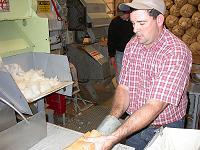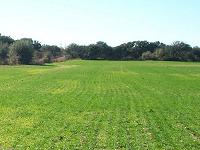

December 2, 2005 |
 |
|---|
 I want to thank Rick Minzenmayer, Steve Estes, Ed Bynum, and Tommy Yeater for their assistance in ginning cotton on November 21 at Lubbock. The fiber samples collected are currently being analyzed. The information will be sent to you as soon as it arrives.
I want to thank Rick Minzenmayer, Steve Estes, Ed Bynum, and Tommy Yeater for their assistance in ginning cotton on November 21 at Lubbock. The fiber samples collected are currently being analyzed. The information will be sent to you as soon as it arrives.
The ginning date for District 6 has been reset to December 12. If you can assist in ginning cotton, please let me know. We usually need four people to get the job done. I need to let all the cotton producing counties know who is going so they can make the necessary arrangements to drop off their gin samples. Linked is a blank gin sheet that will need to be filled out and sent with your cotton samples. The seven-digit sample number is a combination of three numbers: the county number is the first three digits, the producer or plot number is digits 4 and 5, and the sample is assigned a number between 01 and 99 which makes up digits 6 and 7. By using this code, it helps to keep samples from getting lost. Try to have your gin samples between 600 and 650 grams. Thanks.
The Beltwide Cotton Conference will be held in San Antonio, Texas, January 3-6, 2006. This is an excellent meeting for increasing your knowledge about cotton production. The shorten format should be more conducive to all participants.
Due to the lack of soil moisture, several producers have not planted. However, I would expect most of this acreage will be planted before December 15. Due to the impact of cooler temperatures on germination and emergence, planting depth will need to be reduced. The wheat seed should be placed 1.25 to 1.75 inches deep (depending on variety), and the seeding rate should be a minimum of 60 pounds per acre. The seedbed will need to be firm to keep air from reaching the developing root system. For the wheat already established, rainfall is needed to keep this crop growing. Several acres of wheat are growing very slowly due to cold temperatures, moisture stress and/or lack of needed nutrients.
 An inadequate amount of nitrogen is available in some small grain acreage. When the need for nitrogen is not met, small grain plant growth is slower than expected and plant coloration is light green to yellow. An application of nitrogen should be beneficial, however, producers should give special consideration to the type of fertilizer applied. The best choice is going to be ammonium nitrate because half of the nitrogen is in a form that is available to the plant at the time of application. This results in a quick response to the fertilizer applied. Other types of fertilizer have to be converted to a form used by the plant and this conversion is slowed by the cool temperatures. Two considerations when applying fertilizer to small grains: 1) dry fertilizer in contact with a wet soil surface has the potential of releasing nitrogen to the atmosphere instead of being tied up on the clay particles or organic matter. 2) If cattle will be grazing shortly after the fertilizer is applied it may cause some serious health problems, even death.
An inadequate amount of nitrogen is available in some small grain acreage. When the need for nitrogen is not met, small grain plant growth is slower than expected and plant coloration is light green to yellow. An application of nitrogen should be beneficial, however, producers should give special consideration to the type of fertilizer applied. The best choice is going to be ammonium nitrate because half of the nitrogen is in a form that is available to the plant at the time of application. This results in a quick response to the fertilizer applied. Other types of fertilizer have to be converted to a form used by the plant and this conversion is slowed by the cool temperatures. Two considerations when applying fertilizer to small grains: 1) dry fertilizer in contact with a wet soil surface has the potential of releasing nitrogen to the atmosphere instead of being tied up on the clay particles or organic matter. 2) If cattle will be grazing shortly after the fertilizer is applied it may cause some serious health problems, even death.
Considerations of late planted wheat:
The impact of this delay will result in a few phone calls from producers to you. Most likely questions to expect: 1) How long will it take for my small grain to germinate and emerge? With these cool temperatures it will take several weeks for the newly planted acreage to obtain a green cast to it. 2) Why are my plants purple? Due to the cool soil temperatures and the slow plant growth the uptake of phosphorus will be slow and the red to purple coloration will be primarily due to nutrient deficiency. 3) Why isn't the wheat tillering? Tillering is faster when soil temperature is warm and soil moisture and nutrient levels are good. The impact of this will be apparent next spring when the number of tillers per plant will be less than desired. 4) I have a lot of weeds what should I do? The cool air temperatures and slow plant growth will slow the performance of the herbicides applied. Target herbicide application based on the small grain growth stage, as soon as the minimum growth stage is reached apply the product that will control the targeted weed. You can expect the root development of this late planted small grain to be minimal. This will make the plants vulnerable to hot, dry, windy conditions in the spring.
Due to the limited soil moisture supply a number of weed control tests have been postponed until after the first of the year. If the opportunity to establish a test does occur, please let me know as soon as possible so necessary preparations can be made.
For those of you looking for information on weed identification and control, the http://twig.tamu.edu URL may be one you want to bookmark. This site is intended to be a one stop site for information concerning weed identification, herbicide injury and weed control.
Linked are the harvest aid tests conducted in 2005
(HTM files are reports that have tables with treatments linked to pictures of the plot)
Linked are summaries of all the weed control tests conducted in 2005.
On December 8, a five-hour CEU course will be held at Brady. This training is being hosted by Texas Cooperative Extension and the Texas Department of Agriculture. The target audience is ag producers and home owners. For more details and to register for the meeting call Jerry Kidd at (325) 597-1295.
On December 14, a five-hour CEU course will be held at the Taylor County Extension Office. This training is being hosted by Texas Cooperative Extension and the Texas Department of Agriculture. The target audience is ag producers and home owners. For more details and to register for the meeting call Gary Bomar at (325) 672-6048.
 December 1, District Office, Teleconference
December 1, District Office, Teleconference
 December 2, District Office, Southern Rolling Plains Cotton Growers
December 2, District Office, Southern Rolling Plains Cotton Growers
 December 5, District Office, Office Conference
December 5, District Office, Office Conference
 December 5, Tom Green County, Friends of Extension Luncheon
December 5, Tom Green County, Friends of Extension Luncheon
 December 6 & 7, Brown County, Professional Board Meetings
December 6 & 7, Brown County, Professional Board Meetings
 December 8, McCulloch County, Multi-County CEU Meeting
December 8, McCulloch County, Multi-County CEU Meeting
 December 12, Lubbock County, Gin District 6 Cotton Samples
December 12, Lubbock County, Gin District 6 Cotton Samples
 December 14, Taylor County, Regional CEU Meeting
December 14, Taylor County, Regional CEU Meeting
 December 21 - 31, Potter, Randall, & Deaf Smith Counties, Christmas Holiday
December 21 - 31, Potter, Randall, & Deaf Smith Counties, Christmas Holiday
 January 3 - 6, San Antonio, Texas, Beltwide Cotton Conference
January 3 - 6, San Antonio, Texas, Beltwide Cotton Conference
 January 9 - 13, Brazos County, Ag Program Conference
January 9 - 13, Brazos County, Ag Program Conference
 January 17, Glasscock County, Result Demonstration Review
January 17, Glasscock County, Result Demonstration Review
 January 18, Midland County, Soil and Soil Fertility
January 18, Midland County, Soil and Soil Fertility
 January 19 & 20, Potter County, Annual Leave
January 19 & 20, Potter County, Annual Leave
 January 24, Martin County, Permian Basin Cotton Conference
January 24, Martin County, Permian Basin Cotton Conference
 January 25 & 26, Ruidoso, New Mexico, State Cotton Conference
January 25 & 26, Ruidoso, New Mexico, State Cotton Conference
 January 31 - Feb 2, Travis County, Cotton Physiology Meeting
January 31 - Feb 2, Travis County, Cotton Physiology Meeting
| Sincerely,
|